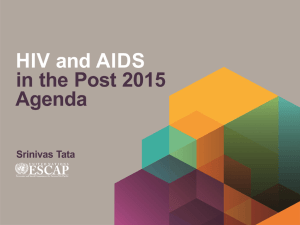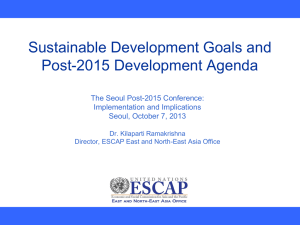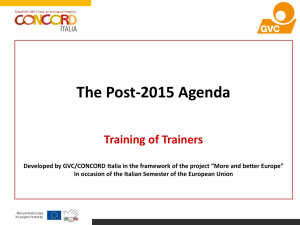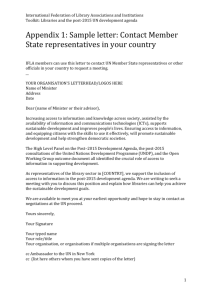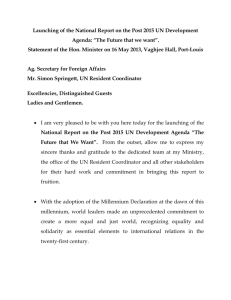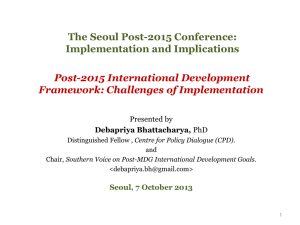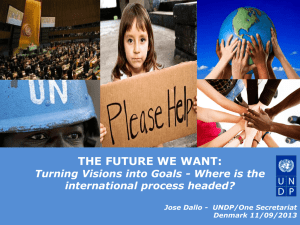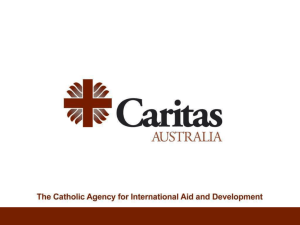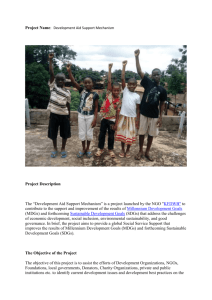The Millennium Development Goals (MDGs) and the Post
advertisement
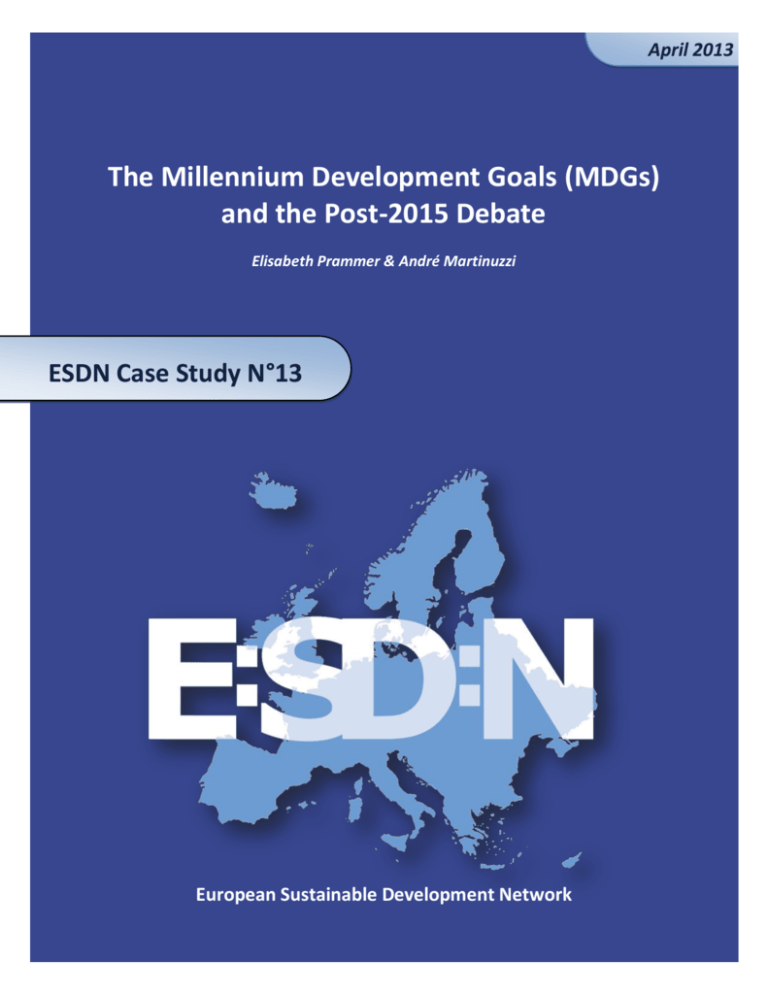
April 2013 The Millennium Development Goals (MDGs) and the Post-2015 Debate Elisabeth Prammer & André Martinuzzi ESDN Case Study N°13 European Sustainable Development Network The Millennium Development Goals (MDGs) and the Post-2015 Debate ESDN Case Study No 13 Author: Elisabeth Prammer & André Martinuzzi Contact: ESDN Office at the Research Institute for Managing Sustainability Vienna University of Economics and Business Franz-Klein-Gasse 1, A-1190 Vienna, Austria English proofreading: Megan Ahearn, University of British Columbia, Canada Visit www.sd-network.eu for Basic information on SD Country profiles Quarterly reports Case studies Conference papers Workshop papers Getting in touch with us The European Sustainable Development Network (ESDN) is an informal network of public administrators and other experts who deal with sustainable development strategies and policies. The network covers all 27 EU Member States, plus other European countries. The ESDN is active in promoting sustainable development and facilitating the exchange of good practices in Europe and gives advice to policy-makers at the European and national levels. © 2013 European Sustainable Development Network (ESDN) 2 The Millennium Development Goals (MDGs) and the Post-2015 Debate ESDN Case Study No 13 Content 1 Introduction ...........................................................................................................................4 2 Post-2015 Framework and SDGs ............................................................................................5 2.1 Important aspects for the post-2015 period ............................................................................. 6 2.2 Measuring development? ........................................................................................................ 8 2.3 Post-2015: Private sector involvement ..................................................................................... 9 3 Rio+20: The Future We Want ...............................................................................................11 4 EC Communication: ‘A Decent Life for All’ (2013) .................................................................13 5 Future Perspectives ..............................................................................................................14 Annex 1: Official list of MDG goals and indicators ...................................................................16 Annex 2: Questionnaire of the public consultation in the EU on post-2015 framework ...........19 References ................................................................................................................................20 3 The Millennium Development Goals (MDGs) and the Post-2015 Debate ESDN Case Study No 13 1 Introduction The Millennium Assembly of the United Nations was held from the 6-8 September 2000 and decided upon the Millennium Declaration which emphasized the need for a global engagement towards developing countries. The Millennium Declaration is a very comprehensive document, from which paragraphs 19 and 20 have been resumed to its general goals which are summarized within the Millennium Development Goals (MDGs). The MDGs consist of 8 main goals (see Figure 1), 21 targets and 43 indicators (see Annex 1). The overall aim was to raise financial means for development after the need for action was defined due to the ‘lost development decade’ of the 1980s. The concept for the MDGs was in principle developed during the 1990s. The Millennium Declaration is dealing with issues that are far broader than the final MDGs. It comprises “environmental pollution, global warming, child labor, human rights violations, the deterioration of social standards like job security, and the fight against corruption“ (R. Bardy et al. 2012:268-269). This is a strength of the MDGs as they comprise global goals with a need to achieve them on a global level. Figure 1: MDG main goals Initially, the main aim of the MDGs was to address the needs of the poorest of the poor, which by definition of the UNDP from a country perspective are LDCs (Least Developed Countries), LLDCs (Land-locked developing countries) and SIDCs (small island developing countries). “The MDGs were meant to broaden the development narrative beyond the narrow growth paradigm” (Vandemoortele 2011:13) which was initially one of the most promising ways to achieve development but, as it turned out, has not proven to be true for all levels of society. Although the MDGs are not fully fulfilled as some countries are still lagging behind, like SubSahara Africa (find more on the MDG Report 2012), one can highlight that they have an incontestable strength. As Vandemoortle (2011:16) argued, “the MDGs have galvanised political commitment as never before”. As they were narrowed down to eight goals, the MDGs were a useful tool for orientation. One major advantage of the MDGs, when comparing them to other declarations, is their simplicity. It can be discussed, of course, if they were unconditionally successful and provided the expected and promised results, but overall they managed to stress the 4 The Millennium Development Goals (MDGs) and the Post-2015 Debate ESDN Case Study No 13 importance for the need to take action in development issues and its most noteworthy issues, like poverty reduction, and they spurred several campaigns. The MDGs will expire in September 2015 – so what comes next? There has already been an intensive discussion on a post-2015 framework and the Sustainable Development Goals (SDGs), which were initiated by the Rio+20 Conference in June 2012. The aim of this case study is to outline the current process, provide an overview of potential future developments, and summarize the most important aspects of the process until now. 2 Post-2015 Framework and SDGs At present, there are two approaches for what should replace the MDGs after 2015: on the one hand, a discussion on a post-2015 framework and, on the other hand, a discussion on the development of Sustainable Development Goals (SDGs). As part of the Rio+20 Summit, which took place in June 2012, the participants agreed on the SDGs to succeed the MDGs. The discussion on the SDGs is led by the 'UN System Task Team on the post-2015 UN Development Agenda' and the 'United Nations Development Programme' (UNDP). The 'Economic and Social Council (ECOSOC)' is a principal body for policy review, policy dialogue and recommendations on issues of economic and social development and for the follow-up to the MDGs (UN 2012:1; ad 82). A 30-member intergovernmental Open Working Group (OWG) of the General Assembly was given the task to prepare a proposal on the SDGs. Moreover, UN Secretary-General Ban Ki-moon announced the 27 members of a High-level Panel that will advise on the global development framework beyond 2015, co-chaired by President Susilo Bambang Yudhoyono of Indonesia, President Ellen Johnson Sirleaf of Liberia, and Prime Minister David Cameron of the United Kingdom and which includes representatives from civil society, the private sector and governments. The Panel will submit a report containing recommendations to the Secretary-General in May 2013. 1 Overall, there is a clear understanding that those two approaches should be merged in order to establish a strong framework for the time post-2015 and to not have two separate tools which would weaken the general debate on development issues. Three options were proposed to work towards in the post-2015 debate: (i) retain the MDGs with some minor changes (MDG1.1); (ii) redesign the architecture and redefine their contents (MDG2.0); or (iii) develop a completely different framework (Vandemoortele 2012:33). For the European level, the EU launched a public consultation from June to September 2012 on the post-2015 debate. In total, 119 organisations and individuals contributed, consisting of 80 1 http://www.un.org/sg/management/hlppost2015.shtml; 23.02.2013 5 The Millennium Development Goals (MDGs) and the Post-2015 Debate ESDN Case Study No 13 NGOs, 9 research institutes, 4 private sector associations, 2 foundations, 2 trade unions, 2 professional organisations, 1 religious authority, 4 local and regional authorities, 1 governmental agency, and 1 national parliament, as well als 4 international organisations and 9 individuals. (EU EDF 2012:43). The questionnaire of the public consultation can be found in Annex 2 of this case study. On the international level, the UN Secretary-General’s initial input to the Open Working Group on Sustainable Development Goals for Rio+20 emphasized several main areas of action. The topics that were regarded as most important for a post-2015 framework were food security & sustainable agriculture, water and sanitation, energy, education, poverty eradication and health. Please see Figure 2 below for an overview of the results of a questionnaire from UN Member States on SDG priory areas. Fig. 2: Secretary-General’s Initial Input to the Open Working Group on Sustainable Development Goals; 2012:8 2.1 Important aspects for the post-2015 period In order to improve efficiency and address the right fields for action, several statements have already been made on what should be taken into account when re-designing MDGs/designing 6 The Millennium Development Goals (MDGs) and the Post-2015 Debate ESDN Case Study No 13 SDGs. The most important and most frequently mentioned areas by the international community (UN), on the European level, and by various stakeholder experts are the following: Country specific approaches: In order to have a proper discussion on how the moving target of MDGs should be changed, one has to bear in mind one major challenge: the goals are valid for every developing country, although problems within developing countries are not the same: “(…) countries have different development starting points, different economies, different capacities, different geography and different problems” (Clarke, Feeny 2011:513). This should be taken into account, especially when measuring and comparing improvements. Stronger focus on human rights: In the Millennium Declaration, human rights were mentioned separately, and the MDGs did not take them up as an individual goal. For post-2015, the need to formulate new and existing goals in the language of human rights was stressed several times. It is important for the post-2015 debate to have a further discussion and inclusion of “human rights, equality and sustainability” orientated towards “inclusive social development, environmental sustainability, inclusive economic development, and peace and security” (UNSG 2012:22). 'Stronger voice for the south': A tenor is that developing countries need a stronger voice in the post-2015 debate. The co-architect of the MDGs, Jan Vandemoortele, emphasizes the need for developing countries to have a strong voice, also in the design of the post-2015 dialogue: “The process must be led by the stakeholders from developing countries; not by those from donor countries.” (Vandemoortele, Delamonica 2009:60) Timeline: One critical aspect will be whether the decision upon new goals will be taken towards short or long-term goals: “Whereas most dimensions of human development do not change significantly over the short-term, long-term targets suffer from weak political accountability, because their deadline will not occur on the watch of the current governments.” (Vandemoortele, Delamonica 2010:63) The current discussion is about short-term and longterm goals. The time horizon for the long-term goals will be “from 2015 to anywhere between 2030 and 2050” (UNSG 2012:37). This would not mean that the current targets are out of date. Just shifting the targets is not useful as the literature states: “The worst option would be to simply keep the same MDGs and set new targets with a new timeline.” (Vandemoortele, Delamonica 2010:60) Avoiding similar goals: Concerning the discussion on the content of the goals, there is one major issue of summarizing similar goals and, therefore, creating space for new ones: The health-related MDGs “could be collapsed into one overall health goal, thereby making space for the inclusion of other areas of concern” (Vandemoortele, Delamonica 2010:63). Vandemoortle stresses the Millennium Declaration as a very important document, but for the 7 The Millennium Development Goals (MDGs) and the Post-2015 Debate ESDN Case Study No 13 post-2015 debate, it is not the sole basis, as the world has undergone severe changes due to the crises influencing not only financial resources, but also the changes of economic power and the shift of developing countries towards emerging markets. Nevertheless, Vandermoortle argues that the Millennium Declaration should serve as a basis for the post2015 debate and the SDGs. Structural causes: Simplicity, as in the MDGs, has the disadvantage that not all aspects of human development can be taken into account. Therefore, complex topics like poverty cannot be measured fully satisfying and giving clear results. Only stating that poverty is a problem does not reveal its structural causes and if they are not properly understood, it cannot be strategically eradicated. Therefore, for the post-2015 period it is proposed that these aspects should get more attention: “By focusing essentially on social objectives and basic needs (such as health, education, water etc.), the MDG framework didn't give enough consideration to the underlying reasons for, and main drivers of poverty.” (EU EDF 2012:17) Pro-Poor Growth: Growth has not always provoked what it was expected to do. Trickle down effects sometimes were low, especially for marginalized groups. Nevertheless, growth and inclusive business are necessary for development and, therefore, pro-poor growth is requested. One measure would be to reduce poverty by employment creation. “Employment creation is the obvious foundation of pro-poor growth.” (Nayyar 2012:15) This aspect is already under consideration for post-2015. Keeping recent MDGs: MDG 5b on sexual and reproductive health has very recently been added to the MDGs. The time period of five years will make it difficult to already have statistical outcomes and measure an improvement. Therefore, WHO (2012:2) proposes to re-include the recent MDGs. 2.2 Measuring development? There is, in general, a problem with data collection and measuring the impact of the MDGs. Although Vandemoortle and Delamonica (2010:63) argue that “the MDGs have caught on so well because of their concise and measurable nature”, the MDGs are facing a problem with its indicators. Therefore, what is important for the post-2015 debate is to find indicators that are based on reliable data which guarantee to be calculated on the same basis and that can be compared. Poku and Whitman (2011:184) take up this issues and argue that “because of differences in compilation methodologies and definitions, some indicators may not be consistent across years because of differences in data sources”. This pontially leads to wrong results, wrong interpretations and bears the danger for inefficient actions. Especially calculating averages has faced manifold critique of leading authors as they can mislead policy-makers: “(…) a 8 The Millennium Development Goals (MDGs) and the Post-2015 Debate ESDN Case Study No 13 good assessment of progress towards the MDGs must go beyond aggregates and averages. (…) [For instance,] a reduction in child mortality does not necessarily mean that child mortality has been reduced for certain disadvantaged groups” (Clarke, Feeny 2011:515). Deciding upon the MDGs that comprise 43 indicators made it possible to calculate complex aspects of development and life in developing countries. The simplification of, in particular, social concerns was a usable approach to measure and calculate, not least because it was possible to measure and monitor progress and also to compare the situation in different countries. Nevertheless, there is a problem with this measurability, especially as societies have changed significantly 2000 and the economic situations are not the same any more. Moreover, there is a certain trickiness with averages: “If one looked at poverty reduction having removed China from the equation, global poverty did not fall much, with Sub-Saharan Africa remaining the lagging region.” (EU EDF 2012:19) Therefore, one central question for the post-2015 debate is the question on how to measure the complexity of social and economic issues. Especially the aggregation of numbers can be difficult in some ways: “A large majority of respondents emphasised that measurement should not be based exclusively on global and aggregate averages that fail to measure inequalities between and within countries.” (EU EDF 2012:40) Also the statistical recording of some groups of the population is problematic: those who are addressed by the MDGs are the poor. But what if “a majority of the poor [is] now living in middle-income countries” (EU EDF 2012:7)? Therefore, special attention has to be given to the aspect of measuring SDGs post-2015, and towards the indicators used or newly created. 2.3 Post-2015: Private sector involvement Efficient use of financial means is one of the priorities of the post-2015 debate. To make aid more efficient and to complement official development assistance (ODA) by other sources is one of the declared aims of the policy coherence for development (PCD). The Busan High Level Forum on Aid Effectiveness in 2011, as review process of the Paris Declaration, agreed on a Global Partnership for Effective Development Cooperation. The European Development Fund in its report suggests using the Busan “Global Partnership for Effective Development Cooperation” as a basis for the post-2015 debate (EU EDF 2012:29). Also the beyond-aid approach (EU EDF 2012:36) intents to raise more financial means for development than only official development assistance. A stronger involvement of the private sector could also be envisaged. However, involving the private sector should not give the current donors an opportunity for an excuse to lower their engagement. Although financial resources are important, development is not only 9 The Millennium Development Goals (MDGs) and the Post-2015 Debate ESDN Case Study No 13 about money, as UNECA pointed out: “Don't get hung up on aid, warns the Economic Commission for Africa. The policies and capacity to deliver on them are what counts.”2 As of now, the chance of including the private sector in the development debate has been largely missed and hence its possibility to contribute to the MDGs: “(…) discussions on a new framework have to date mostly included development practitioners, governments and nongovernmental organisations (NGOs) and have largely excluded the private sector”. (Lucci 2012: vi). However, an involvement of the private sector could be crucial: “Over half of global foreign direct investment (FDI) inflows are going to developing countries. These flows ($574 billion in 2010; UNCTAD, 2011a) are four times larger than official development assistance (ODA) ($128 billion in 2010; OECD, 2012)”. (Lucci 2012:3) Merging government and companies’ interests and abilities have so far resulted in Economic Partnership Agreements (EPA). But those projects are rather small-scale and have not yet targeted multinational companies (MNCs). Nevertheless, they create valuable synergies: “The host country’s efforts and the investors' endeavors will meet in a two-way give and take: e.g., if the host country wishes to step up education, and investors need skilled labor, a combined effort will be the most productive.” (R. Bardy et al. 2012:272) Efforts made by companies are mostly done by philanthropic activities. This philanthropist engagement of private investors has eased access of MNCs towards the development debate: “In addition, the increasing influence of a number of philanthropists with a private sector background has helped to facilitate partnerships between different actors and sectors and to promote greater private sector engagement in development.” (Lucci 2012:1) But what is missing is a structured engagement of the private sector and its core business: “FDI could increase greatly in the coming decade if appropriate strategies and policies are put in place with concerted efforts from governments in LDCs and development partners and the active involvement of the private sector.” (Lucci 2012:4) Private sector involvement is important and, without it, some well-proven ways for development, like microfinance, would not have been possible: “As a matter of fact, many respondents noted that the private sector already played an important role in development, [by] Corporate Social Responsibility initiatives, Public-Private Partnerships, joint innovation and inclusive business models. (...) [Especially] financial private institutions such as banks and microfinance organisations play a key role to facilitate access to credit, savings and insurance options for the poor." (EU EDF 2012:30) However, there is a “need to go beyond such voluntary initiatives and move towards more binding mechanisms”, as argued by EU EDF Program (2012:30), which could possible create a chance for systematic inclusion, not only motivating MNCs or SMEs to do voluntary engagement or CSR activities, but to really engage companies in the development debate. The EU EDF Program also emphasizes the need for a better reporting of what compa2 http://www.uneca.org/mdgs/Story1September05.asp; 21.02.2013 10 The Millennium Development Goals (MDGs) and the Post-2015 Debate ESDN Case Study No 13 nies do towards engagement in human rights, in anti-corruption, transparency, and also towards environmental aspects and an assessment of positive and negative impacts is necessary. 3 Rio+20: The Future We Want At the United Nations Conference on Sustainable Development (Rio+20 Conference) in June 2012, an outcome document, called 'The Future We Want', was agreed upon. This outcome document also includes the paragraphs (para 245-251) on the Sustainable Development Goals (SDGs). To present an overview of the SDGs, the most important fields of action were taken out and we grouped them in categories in Table 1 below on the basis of issues discussed by the UN System Task Team on the post-2015 UN Development Agenda (see also References in this case study). Category Fields of action Poverty eradication o Poverty eradication is high on the list o Changing unsustainable and promoting sustainable patterns of consumption and production o Active engagement of the public and the private sectors, foster publicprivate partnerships, engage in responsbile business practices (e.g. UN Global Compact) (UN 2012; para 46) o Employment building (UN 2012; para 24) o Inclusive and equitable economic growth (UN 2012; para 4) o Establish a green sector and create green jobs (UN 2012; para 154) o Generate decent jobs and decrease disparities in standards of living (UN 2012; para 30), particularly for women, youth and the poor (UN 2012; para 62) o Consider the green economicy as one of the important tools for achieving sustainable development (UN 2012; para 56) o Sustainable transport (UN 2012:25) o Leverage private resource flows (UN 2012; para 260) o Sustainable tourism (UN 2012:25) o Protecting and managing the natural resource base of economic and social development o Combating Climate Change with amibitious action (UN 2012; para 25) o Prevent deforestation (UN 2012; para 193); fight against the loss of biodiversity (UN 2012; para 197), desertification, land degradation and Strengthening Business Environment 11 The Millennium Development Goals (MDGs) and the Post-2015 Debate ESDN Case Study No 13 drought (UN 2012; para 205) o Raise public awareness on environemental issues (UN 2012; para 88e) o Food Security (UN 2012; para 108); stress healthy marine ecosystems ans sustainable fisheries (UN 2012; para 114); guarantee access to safe drinking water and basic sanitation (UN 2012; para 120) o Sound management of chemicals and of hazardous waste (UN 2012; para 213) o Human Rights, democracy, good governance and the rule of law (UN 2012; para 10) o Enhance social protection (UN 2012; para 107) o Stress the importance of the participation of indigenious peoples (UN 2012; para 46) o Remove obstacles and constraints within humanitarian emergencies and in areas affected by terrorism (UN 2012; para 29) o Improve development effectiveness (UN 2012; para 259) o Greater coherence and coordination among the various funding mechanisms (UN 2012; para 262) o Fighting corruption and illicit financial flows (UN 2012; para 266) Gender o Ensure equal gender rights (UN 2012; para 31) ICT o Bridge the digital divide (UN 2012; para 44) o Importance of evaluation (UN 2012; para 63) Measuring o Ensure gender equality and the empowerment of women (UN 2012:44); use of gender-sensitive indicators and sex-disaggregated data (UN 2012; para 239) MDG 8 Develop a global partnership o Promote a strong science-policy interface (UN 2012; para 88d) o Give access to sustainable modern energy service – Energy for All (UN 2012; para 125; 129) o Achieve universal access to and maintain health (UN 2012; para 140), ensure sexual and reproductive health (UN 2012; para 145) o Reduce maternal and child mortality, improve helath of women, youth and children (UN 2012; para 146) Human Rights Developing country led dialogue Making aid more efficient Energy Health Table 1: Categories and fields of action of SDGs, based on work of the UN System Task Team on the post-2015 UN Development Agenda 12 The Millennium Development Goals (MDGs) and the Post-2015 Debate ESDN Case Study No 13 4 EC Communication: ‘A Decent Life for All’ (2013) In February 2013, the EU published the communication “A Decent Life for All: Ending poverty and giving the world a sustainable future” to foster a common approach between the current discussions (SDGs, post-2015 framework, and the positions within EU and UN). The Commissioner for Development, Andris Piebalgs, emphasized that commitment and political will are more necessary than ever to achieve improvements. Therefore, the set of goals should be action-orientated. For the first time, a timeline is mentioned by when the new process should show success: The long term vision is by 2050, the goals and targets focus on 2030. In this Communication, the EU also proposes that SDGs should merge with the post-2015 framework. The key factors to bear in mind are: ensuring basic living standards; inclusive and sustainable growth; sustainable resource management; and equality, equity, justice and peace and security. As argued in this Communication, poverty reduction can only be successful if it is linked to global environmental sustainability (EU EC 2013:8). And unsustainable use of natural resources is a major problem in developing countries (EU EC 2013:11), but “the effects (…) are still largely determined by developed countries and increasingly by emerging economies” (EU EC 2013:4). So only a global approach on these issues can achieve success in the context of a global set of SDGs. Also included in the Communication is the argument that a strong focus has to be given towards good governance. Those countries that have had little or no improvements towards the MDGs are mostly lacking in democracy, rule of law and respect for human rights. As the world has undergone major changes and various crises, their results also have an impact on the MDGs. Therefore, there are some challenges to be faced: Underemployment and exclusion from the labour market, especially concerning those without good education and women. Informal work is a problem with a view towards social protection and working conditions as such. Resource use is important to act against climate change and meet the future need for agricultural use of land due to a predicted growth in population. Sub-Sahara Africa is a problematic region having the biggest steps to take. The region is faced by gender inequality, health problems (HIV/Aids), and lack of food security. Development aid has in some cases been claimed not to be efficient enough, so one requirement is to avoid “duplication of efforts as regards the financing for development 13 The Millennium Development Goals (MDGs) and the Post-2015 Debate ESDN Case Study No 13 process” (EU EC 2013:7) and to foster also coherence in work (e.g. disaster risk reduction). This can be done with a thought towards private sector inclusion. The issue of measurability is stressed as well: “We must move from purely quantitative goals to address quality, for example in education and health.” (EU EC 2013:9) The commitment of the EU will be guided by the Europe 2020 Strategy and existing international agreements (e.g. towards climate change). A full list of upcoming events influencing the political and legal framework (as, e.g. common fishery policies) that is influencing the MDGs can be found in the Annex of the Communication. 5 Future Perspectives The MDGs have, in general, the power to mobilize the international community to raise money and take action for development issues that still had to be improved. But nevertheless, there is still a lot to do. As MDGs will expire in 2015, there is already a discussion on what will follow. The UN agreed on Sustainable Development Goals (SDGs) which should be the successor of the MDGs in the period post-2015. The post-2015 process is already on its way. In June 2012, the Rio+20 Summit took place and produced an outcome document, called 'The Future We Want', where the issues that should guide the SDG process were outlined. Some of the SDGs are the re-integration of the existing MDGs, like poverty reduction, education and developing a global partnership, as well as gender issues. However, there are also some additional goals proposed to be added. They have not been major issues in the 90s and 2000s, when the MDGs were implemented, but are now seen of great importance, e.g. energy issues and a special focus towards human rights. In order to provide efficient action, aid efficiency and efficiency as an overall aim should be addressed. This can be done by taking a closer look into evaluation, measuring and setting a list of reliable indicators, but also to provide a perspective behind the structures of the problems, to better understand and to better improve current weaknesses. In support of this, the integration of the private sector is useful and should be further investigated. As the SDG process is still ongoing and consultations are currently taking place, the most important event will be the 68th General Assembly of the United Nations Secretary General, which will be held in September 2013 and the Open Working Group will present its report. The aim is to decide upon methods of work and modalities how the relevant experts and stakeholders can be involved. As a result, and in cooperation of the United Nations with scientists, a proposal will 14 The Millennium Development Goals (MDGs) and the Post-2015 Debate ESDN Case Study No 13 be submitted to the General Assembly what to consider for the SDGs3. Please find in the table below an overview of ongoing and future important events: United Nations Development Group Meeting Themes of Global meetings: 05/2012- 02/2013 31/05/2013 o Inequalities (across all dimensions, including gender) o Health (including issues covered by MDGs 4, 5, 6, plus non communicable diseases) o Education (primary, secondary, tertiary and vocational) o Growth and employment (including investment in productive capacities, decent employment, and social protection) o Environmental sustainability (including access to energy, biodiversity, climate change) o Food security and nutrition o Governance (at all levels) o Conflict and fragility (including post-conflict countries, and those prone to natural disasters) o Population dynamics (including ageing, international and internal migration, and urbanisation) Un Secretary General Consultation, also with expert group on SDGs will submit its report to the Secretary General on 31 May 2013. UN General Assembly (UNGA) MDG Review Summit 09/2013 The UN Secretary-General will present his post-2015 vision for sustainable development at the 68th General Assembly in September 2013 09/2014 UN Review of the Political Declaration on NCDs 01/2015 – 12/2015 Intergovernmental negotiations process in UN General Assembly on post-2015 07 - 09/2015 UN General Assembly Post-MDG Review Summit Table 2: Important events for the SDG process in the UN system: 3 http://www.unhabitat.org/categories.asp?catid=746 15 The Millennium Development Goals (MDGs) and the Post-2015 Debate ESDN Case Study No 13 Annex 1: Official list of MDG goals and indicators Official list of MDG indicators All indicators should be disaggregated by sex and urban/rural as far as possible. Effective 15 January 2008 Goals and Targets Millennium Development Goals (MDGs) Indicators for monitoring progress (from Millennium Declaration) Goal 1:the Eradicate extreme poverty and hunger Target 1.A: Halve, between 1990 and 2015, the proportion of people whose income is less than one dollar a day Target 1.B: Achieve full and productive employment and decent work for all, including women and young people Target 1.C: Halve, between 1990 and 2015, the proportion of people who suffer from hunger 1.1 Proportion of population below $1 (PPP) per daya 1.2 Poverty gap ratio 1.3 Share of poorest quintile in national consumption 1.4 Growth rate of GDP per person employed 1.5 Employment-to-population ratio 1.6 Proportion of employed people living below $1 (PPP) per day 1.7 Proportion of own-account and contributing family workers in total employment 1.8 Prevalence of underweight children under-five years of age 1.9 Proportion of population below minimum level of dietary energy consumption Goal 2: Achieve universal primary education Target 2.A: Ensure that, by 2015, children everywhere, boys and girls alike, will be able to complete a full course of primary schooling 2.1 Net enrolment ratio in primary education 2.2 Proportion of pupils starting grade 1 who reach last grade of primary 2.3 Literacy rate of 15-24 year-olds, women and men Goal 3: Promote gender equality and empower women Target 3.A: Eliminate gender disparity in 3.1 Ratios of girls to boys in primary, secondary and tertiary primary and secondary education, prefereducation ably by 2005, and in all levels of education 3.2 Share of women in wage employment in the nonno later than 2015 agricultural sector 3.3 Proportion of seats held by women in national parliament Goal 4: Reduce child mortality Target 4.A: Reduce by two-thirds, between 1990 and 2015, the under-five mortality rate Goal 5: Improve maternal health Target 5.A: Reduce by three quarters, between 1990 and 2015, the maternal mortality ratio Target 5.B: Achieve, by 2015, universal access to reproductive health 4.1 Under-five mortality rate 4.2 Infant mortality rate 4.3 Proportion of 1 year-old children immunised against measles 5.1 Maternal mortality ratio 5.2 Proportion of births attended by skilled health personnel Contraceptive prevalence rate 5.3 5.4 Adolescent birth rate 5.5 Antenatal care coverage (at least one visit and at least four visits) 5.6 Unmet need for family planning 16 The Millennium Development Goals (MDGs) and the Post-2015 Debate ESDN Case Study No 13 Goal 6: Combat HIV/AIDS, malaria and other diseases Target 6.A: Have halted by 2015 and 6.1 HIV prevalence among population aged 15-24 years begun to reverse the spread of 6.2 Condom use at last high-risk sex HIV/AIDS 6.3 Proportion of population aged 15-24 years with comprehensive correct knowledge of HIV/AIDS 6.4 Ratio of school attendance of orphans to school attendance of non- orphans aged 10-14 years Target 6.B: Achieve, by 2010, universal access to treatment for HIV/AIDS for all those who need it 6.5 Proportion of population with advanced HIV infection with access to antiretroviral drugs Target 6.C: Have halted by 2015 and begun to reverse the incidence of malaria and other major diseases 6.6 Incidence and death rates associated with malaria 6.7 Proportion of children under 5 sleeping under insecticidetreated bednets 6.8 Proportion of children under 5 with fever who are treated with appropriate anti-malarial drugs 6.9 Incidence, prevalence and death rates associated with tuberculosis 6.10 Proportion of tuberculosis cases detected and cured under directly observed treatment short course Goal 7: Ensure environmental sustainability Target 7.A: Integrate the principles of sustainable development into country policies and programmes and reverse the loss of environmental resources Target 7.B: Reduce biodiversity loss, achieving, by 2010, a significant reduction in the rate of loss 7.1 7.2 7.3 7.4 7.5 7.6 7.7 Proportion of land area covered by forest CO2 emissions, total, per capita and per $1 GDP (PPP) Consumption of ozone-depleting substances Proportion of fish stocks within safe biological limits Proportion of total water resources used Proportion of terrestrial and marine areas protected Proportion of species threatened with extinction Target 7.C: Halve, by 2015, the proportion of people without sustainable access to safe drinking water and basic sanitation 7.8 Proportion of population using an improved drinking water source 7.9 Proportion of population using an improved sanitation facility Target 7.D: By 2020, to have achieved a significant improvement in the lives of at least 100 million slum dwellers 7.10 Proportion of urban population living in slums b 17 The Millennium Development Goals (MDGs) and the Post-2015 Debate ESDN Case Study No 13 Goal 8: Develop a global partnership for development Target 8.A: Develop furSome of the indicators listed below are monitored separately for the least develther an open, rule-based, oped countries (LDCs), Africa, landlocked developing countries and small island predictable, non- disdeveloping States. criminatory trading and Official development assistance (ODA) financial system 8.1 Net ODA, total and to the least developed countries, as percentage of OECD/DAC donors’ gross national income Includes a commitment to 8.2 Proportion of total bilateral, sector-allocable ODA of OECD/DAC donors to basic good governance, developsocial services (basic education, primary health care, nutrition, ment and poverty reduction safe water and sanitation) – both nationally and inter8.3 Proportion of bilateral official development assistance of OECD/DAC nationally donors that is untied 8.4 ODA received in landlocked developing countries as a proportion of their gross Target 8.B: Address the special national incomes needs of the least developed coun8.5 ODA received in small island developing States as a proportion of their gross tries national incomes Market access Includes: tariff and quota free ac- 8.6 Proportion of total developed country imports (by value and excluding arms) cess for the least developed counfrom developing countries and least developed countries, admitted free of tries' exports; enhanced produty gramme of debt relief for heavily 8.7 Average tariffs imposed by developed countries on agricultural products indebted poor countries (HIPC) and and textiles and clothing from developing countries cancellation of official bilateral 8.8 Agricultural support estimate for OECD countries as a percentage of their debt; and more generous ODA for gross domestic product countries committed to poverty re- 8.9 Proportion of ODA provided to help build trade capacity duction Debt sustainability 8.10 Total number of countries that have reached their HIPC decision points and number that have reached their HIPC completion points (cumulative) Target 8.C: Address the special 8.11 Debt relief committed under HIPC and MDRI Initiatives needs of landlocked developing 8.12 Debt service as a percentage of exports of goods and services countries and small island developTarget 8.E: In cooperation with 8.13 Proportion of population with access to affordable essential drugs on a susing States (through the Programme pharmaceutical companies, protainable basis of Action fortothe Sustainable Develvide access affordable essential Target 8.F: In cooperation with the 8.14 Fixed telephone lines per 100 inhabitants drugs developing countries opment of Small Island Developing privateinsector, make available the 8.15 Mobile cellular subscriptions per 100 inhabitants States and of thees- 8.16 Internet users per 100 inhabitants benefits of the newoutcome technologies, The Millennium Development Goalsof and targets come from the Millennium Declaration, signed by 189 countries, including 147 heads of pecially information and communitwenty-second special session State and Government, in September cations the General Assembly) 2000 (http://www.un.org/millennium/declaration/ares552e.htm) and from further agreement by member states at the 2005 World Summit (Resolution adopted by the General Assembly - A/RES/60/1, http://www.un.org/Docs/journal/asp/ws.asp?m=A/RES/60/1). The goals and targets are interrelated and should be seen as a whole. They represent a partnership between the developed countries and the developTarget 8.D: Deal comprehensively ing countries “to create an environment – at the national and global levels alike – which is conducive to development and the elimination with the debt problems of develof poverty”. oping countries through national a For and international measures in or- indicators based on national poverty lines should be used, where available. monitoring country poverty trends, der to make debt sustainable in b The the long term actual proportion of people living in slums is measured by a proxy, represented by the urban population living in households with at least one of the four characteristics: (a) lack of access to improved water supply; (b) lack of access to improved sanitation; (c) overcrowding (3 or more persons per room); and (d) dwellings made of non-durable material. Source: MDG targets, subtargets and indicators: http://mdgs.un.org/unsd/mdg/Resources/Attach/Indicators/OfficialList2008.pdf; 27.02.2013 18 The Millennium Development Goals (MDGs) and the Post-2015 Debate ESDN Case Study No 13 Annex 2: Questionnaire of the public consultation in the EU on post-2015 framework Questionnaire of the public consultation: on the Consultation Process on "Towards a Post-2015 Development Framework"; 2012:42; http://ec.europa.eu/europeaid/what/millenium-development-goals/documents/12-1206_report-final.pdf; 23.02.2013 19 The Millennium Development Goals (MDGs) and the Post-2015 Debate ESDN Case Study No 13 References Bardy, Roland; Drew, Stephen; Kennedy, Tumenta F. (2012): Foreign Investment and Ethics: How to Contribute to Social Responsibility by Doing Business in Less-Developed Countries. In: Journal of Business Ethics (106), S. 267-282. Busan Partnership for Effective Development Co-Operation. Fourth High Level Forum on Aid Effectiveness; Busan; 2011; http://www.oecd.org/dac/effectiveness/49650173.pdf; 25.02.2013 Clarke, Matthew; Feeny, Simon: Old challenges and new opportunities for the MDGs: now and beyond 2015; Journal of the Asia Pacific Economy; 16 (4); 2011:509-519 Commission on Sustainable Development (CSD): http://sustainabledevelopment.un.org/csd.html; 24.02.2013 Communication from the Commission to the Council, The European Parliament, The European Economic and Social Committee and the Committee of the Regions: Policy Coherence for Development - Establishing the policy framework for a whole–of–the-Union approach http://ec.europa.eu/development/icenter/repository/COM_2009_458_part1_en.pdf; 26.02.2013 Communication from the Commission to the European Parliament, The Council, The European Economic and Social Committee and the Committee of the Regions; Rio+20: Towards the green economy and better governance: http://eurlex.europa.eu/LexUriServ/LexUriServ.do?uri=COM:2011:0363:FIN:EN:PDF; 22.02.2013 DG Environment; Rio+20: United Nations Conference on Sustainable Development: http://ec.europa.eu/environment/international_issues/rio20_en.htm; 21.02.2013 Economic Commission for Africa: http://www.uneca.org/mdgs/Story1September05.asp; 21.02.2013 EU EC: Communication from the Commission to the European Parliament, the Council, the European Economic and Social Committee and the Committee of the Regions: A Decent Life for All: Ending poverty and giving the world a sustainable future; Brussels; COM(2013) 92 final; http://ec.europa.eu/europeaid/documents/2013-0222_communication_a_decent_life_for_all_post_2015_en.pdf; 08.03.2013 European Commission: Towards a post-2015 development framework. Public Consultation; http://ec.europa.eu/europeaid/how/public-consultations/documents/1206_consultation_post2015_development_en.pdf; 23.02.2013 EU EDF – European Union’s EDF Programme (Jones, Alexei): Report on the Consultation Process on "Towards a Post-2015 Development Framework"; Letter of Contract N°2012/294488; 2012; http://ec.europa.eu/europeaid/what/millenium-development-goals/documents/12-12-06_reportfinal.pdf; 23.02.2013 20 The Millennium Development Goals (MDGs) and the Post-2015 Debate ESDN Case Study No 13 Green, Duncan; Hale, Stephen; Lockwood, Matthew: Oxfam Discussion Paper: How can a post-2015 agreement drive real change?; London; 2012 Lucci, Paula (Overseas Development Institute): Post-2015 MDGs – What role for business?; London; 2012 Millennium Development Goals Report http://www.un.org/millenniumgoals/pdf/MDG%20Report%202012.pdf; 22.02.2013 2012: OECD: The DAC Guidelines Strategies for Sustainable Development; http://www.oecd.org/dac/environment-development/2669958.pdf; 21.02.2013 2001 Poku, Nana K.; Whitman, Jim: The Millennium Development Goals and Development after 2015; Third World Quarterly; 32(1); 2011:181-198 Report of the Secretary-General United Nations system support for the New Partnership for Africa’s Development http://www.un.org/ga/search/view_doc.asp?symbol=E/AC.51/2009/7; 23.02.2013 Rio+20: Outcome and follow-up to the UNCSD 2012 Summit - Council http://register.consilium.europa.eu/pdf/en/12/st15/st15477.en12.pdf; 24.02.2013 conclusions Secretary-General’s Initial Input to the Open Working Group on Sustainable Development Goals: http://www.unhabitat.org/downloads/docs/11860_1_594730.pdf; 22.02.2013 Secretary-General's 24.03.2013 High-Level Panel: http://www.un.org/sg/management/hlppost2015.shtml, UN Conference on Sustainable Development, RIO + 20; Contribution by the European Union and its Member States to the UN Department of Economic and Social Affairs; 2012: http://ec.europa.eu/environment/international_issues/pdf/rio/EU%20Submission%20to%20the% 20Zero%20Draft%20of%20the%20Outcome%20Documnet.pdf; 22.02.2013 UN Criteria for LDCs, LLDCs, SIDCs: http://www.unohrlls.org/en/ldc/164/; 27.02.2013 UN Habitat Post 2015 Timeline: http://www.unhabitat.org/categories.asp?catid=746; 22.02.2013 UN MDG targets, subtargets and indicators: http://mdgs.un.org/unsd/mdg/Resources/Attach/Indicators/OfficialList2008.pdf; 27.02.2013 UN System Task Team on the post-2015 UN Development Agenda; ECE, ESCAP, UNDESA, UNEP, UNFCCC Building on the MDGs to bring sustainable development to the post-2015 development agenda Thematic Think Piece, May 2012 http://www.un.org/millenniumgoals/pdf/Think%20Pieces/17_sustainable_development.pdf; 22.02.2013 UN System Task Team on the post-2015 UN Development Agenda; ECE, ESCAP, UNDESA, UNICEF, UNRISD, UN Women: Addressing inequalities: The heart of the post-2015 agenda and the future 21 The Millennium Development Goals (MDGs) and the Post-2015 Debate ESDN Case Study No 13 we want for all; 2012; http://www.un.org/millenniumgoals/pdf/Think%20Pieces/10_inequalities.pdf; 21.02.2013 UN System Task Team on the post-2015 UN Development Agenda; New partnerships to implement a post-2015 development agenda. March 2012; http://www.un.org/millenniumgoals/pdf/global_partnerships_Aug.pdf; 21.02.2013 UN System Task Team on the post-2015 UN Development Agenda; OHCHR; Towards freedom from fear and want: Human rights in the post-2015 agenda; Thematic Think Piece; 2012; http://www.un.org/millenniumgoals/pdf/Think%20Pieces/9_human_rights.pdf; 21.02.2013 UN System Task Team on the post-2015 UN Development Agenda; The MDGs after 2015: Some reflections on the possibilities. http://www.un.org/millenniumgoals/pdf/deepak_nayyar_Aug.pdf; 25.02.2013 UN System Task Team on the post-2015 UN Development Agenda; UNAIDS, UNICEF, UNFPA, WHO: Health in the post-2015 UN development agenda Thematic Think Piece; May 2012 http://www.un.org/millenniumgoals/pdf/Think%20Pieces/8_health.pdf; 21.02.2013 UN System Task Team on the post-2015 UN Development Agenda; Vandemoortele, Jan: Advancing the global development agenda post-2015: some thoughts, ideas and practical suggestions. April 2012; http://www.un.org/millenniumgoals/pdf/jan_vandemoortele_Aug.pdf; 25.02.2013 UN System Task Team on the post-2015 UN Development Agenda; Von der Hoeven, Rolph: MDGs post 2015: Beacons in turbulent times or false lights?; http://www.un.org/millenniumgoals/pdf/rolph_van_der_hoeven.pdf; 25.02.2013 UN: Keeping the promise: a forward-looking review to promote an agreed action agenda to achieve the Millennium Development Goals by 2015 Report of the Secretary-General* http://www.un.org/ga/search/view_doc.asp?symbol=A/64/665&referer=http://www.un.org/mill enniumgoals/reports.shtml&Lang=E; 23.02.2013 UN: Key Dates for the post-2015 UN Development Agenda; http://www.idf.org/key-dates-post-2015-undevelopment-agenda; 24.02.2013 United Nations Conference on Sustainable Development: The Future We Want; Jänner 2012 http://www.uncsd2012.org/rio20/content/documents/370The%20Future%20We%20Want%2010 Jan%20clean.pdf; 21.02.2013 UNSG: Realizing the Future We Want for All. Report to the Secretary-General; New York; 2012 Vandemoortele, Jan: If not the Millennium Development Goals, then what? Third World Quarterly; 32 (1); 2011:9-25 Vandemoortele, Jan; Delamonica, Enrique: Taking the MDGs Beyond 2015: Hasten Slowly; IDS Bulletin Institute of Development Studies; 41 (1); 2010:61-69 22 The Millennium Development Goals (MDGs) and the Post-2015 Debate ESDN Case Study No 13 WHO: Informal Member State Consultation on Health in the Post 2015 Development Agenda, Summary Report, 14 December 2012 http://www.who.int/topics/millennium_development_goals/post2015/summary_informal_consultation _memberstates_20121214.pdf; 21.02.2013 Fig. 1: The 8 MDGs: http://www.un.org/millenniumgoals/reports.shtml; 21.02.2013 Fig. 2: http://www.unhabitat.org/downloads/docs/11860_1_594730.pdf; 22.02.2013 23 European Sustainable Development Network (ESDN) www.sustainability.eu
